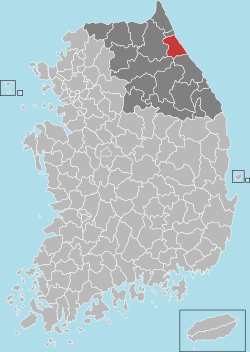Yangyang County
This article needs additional citations for verification. (September 2018) |
Yangyang
양양군 | |
|---|---|
| Korean transcription(s) | |
| • Hangul | 양양군 |
| • Hanja | 襄陽郡 |
| • Revised Romanization | Yangyang-gun |
| • McCune-Reischauer | Yangyang-gun |
 Location in South Korea | |
| Country | |
| Region | Gwandong |
| Administrative divisions | 1 eup, 5 myeon |
| Area | |
| • Total | 628.68 km2 (242.73 sq mi) |
| Population (2000) | |
| • Total | 30,141 |
| • Density | 50/km2 (100/sq mi) |
| • Dialect | Gangwon |
Yangyang County (Yangyang-gun) is a county in Gangwon Province, South Korea. The county is located in the northeast of the country in Gangwon-do. Its population is about 31,000 (2004).
The Yangyang area is well known for its pine mushrooms (song-i), its fish—particularly salmon—and its sunrises.
Overview
In 2002, Yangyang opened its own airport, serving Busan and two cities in China. The airport also served Gangneung to the south and Sokcho to the north. It was intended for the many tourists attracted by the Seorak-san national park. But, as of 2009, the airport closed due to a lack of passengers.[1]
The county is proud to unite the five major religious influences in South Korea: Confucianism, Buddhism, Shamanism, Protestantism and Roman Catholicism. There are sites for all these movements in Yangyang. The Seonghwangsa is a shamanistic altar which was traditionally used for sacrificial rites. Yangyang Hyanggyo is a Confucian school, built in 1340. Today the school mainly serves as a shrine, but some classes are still held at the site. In 1921 the Yangyang Cathedral was built. During the Korean War it was burnt to the ground, but rebuilt after.
The county is also proud of its five-day market. It is the largest traditional market in the area and renowned for the quality of its produce. The market is held on days ending in 4 and 9.
Tourism
- Naksansa(洛山寺)
- Uisangdae(義湘台)
- Junjisaji pagoda(陳田寺址三層石塔)
- Naksan Beach
- Osan Beach
- Dongho Beach
- Hajodae Beach
- Ingu Beach
- Jigyeong Beache
References
- ^ Sudworth, John (2009-05-18). "World | Asia-Pacific | South Korea's abandoned airports". London: BBC News. Retrieved 2009-05-19.


